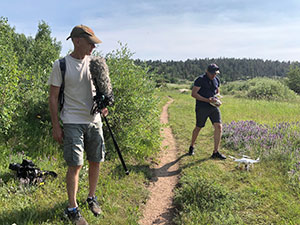UWs Aerosol Research To Be Highlighted in Documentary That Will Air on French TV in 2022
Published September 16, 2021

The University of Wyoming Department of Atmospheric Science recently received some international attention for its expertise. And that knowledge is expected to show up in a French documentary film about aerosols sometime next year.
Daniel McCoy, an assistant professor, and Larry Oolman, a senior research scientist, both in the Department of Atmospheric Science, were interviewed for a 90-minute documentary that is expected to be completed early next year, with a prime-time air date on France 5 in summer 2022. France 5, much like PBS in America, is a French free-to-air public channel that primarily features educational programming. The working title of the documentary is “The Earth, a living body.” Two 52-minute versions, to be edited for a miniseries, will be made for international distribution.
“The section we contributed to is about clouds and aerosols, with a focus on aerosols that come from natural sources, such as sea spray and dust,” McCoy says. “The documentary is set to appear on France 5 but could potentially air in the U.S. at some future date.”
The film crew, from Mona Lisa Production in Lyon, France, and led by director Pierre-François Gaudry, was on UW’s campus July 2-3. Filming took place in the 3D Visualization Center in the Energy Innovation Center; the UW Flight Center, which houses the King Air research aircraft; and the National Center for Atmospheric Research (NCAR)-Wyoming Supercomputing Center (NWSC) in Cheyenne.
“UW’s Department of Atmospheric Science is one of the world leaders in understanding the physics of clouds, and one aspect of this is understanding aerosol-cloud interactions,” McCoy says. “We have pretty unique facilities to do this through the National Science Foundation-supported aircraft that the department manages and our access to the NWSC.”
A lot of modeling work has taken place at the NWSC. UW atmospheric science faculty members, using the King Air research aircraft, have conducted numerous experiments and made countless observations of clouds, aerosols and trace gases. Additionally, department faculty members have published various papers on aerosol.
“Clouds need aerosol particles to form droplets on. More aerosol of the right size and chemistry means more cloud droplets in a given cloud,” McCoy explains. “If you have a fixed mass of water in your cloud, making it up of a lot of little drops instead of a few big ones gives you a brighter cloud because scattering of sunlight goes as surface area.”
Aerosol emitted by industrial activity has cooled the planet through this and other processes. Understanding how much cooling has occurred is important to interpreting the observational temperature record and predicting how climate will look in the future, he says. Understanding the pre-industrial baseline set by nonanthropogenic aerosol sources is critical to understanding how big of an effect anthropogenic aerosol has had.
“One of the more important nonanthropogenic sources of aerosol is from marine phytoplankton,” McCoy says. “They produce dimetylsulfide, which oxidizes into sulfate in the atmosphere. Volcanic sulfur and sea salt are other examples. Another example might be Saharan dust, which is less good at nucleating cloud droplets. But, because of its crystallographic structure, it has a different very important effect: allowing super cooled liquid (less than 32 degrees Fahrenheit) to freeze into ice.”
Lulin Xue, a project scientist at NCAR’s Research Applications Lab, also was interviewed for the documentary. Other filming locations for the documentary include Woods Hole Oceanographic Institution in Falmouth, Mass.; Biosphere 2, an American earth system science research facility in Oracle, Ariz.; and the Azores in Portugal.

